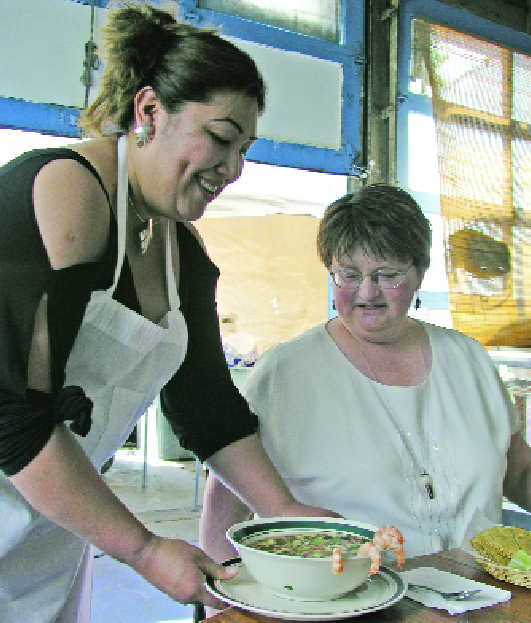
Florinda Puebla serves Caldos de Mariscos (Seafood Stew) to Nanette Lee, with Lee’s special request granted: “No pulpo, por favor.” (No octopus, please.)
(Photo by Jim Black)
Living in a multilingual society, occasionally I would feel the need to dredge up my rusty Spanish vocabulary and express some thought. But no matter how pressing I felt the need, I never spoke. Fear of embarrassing myself topped the “Good Reasons To Stay Silent” list.
Although I did remember many Spanish words from my foreign language class at Wapato High School, near Yakima, Washington, the exact meaning had become lost over the years.
Did “hambre” mean “hungry” or “male person”? An important distinction to be aware of in a restaurant, where the last thing I’d want would be to announce, “I am a man,” when all I really wanted was a combination plate.
When a chance to study in a Spanish immersion class at La Casa Hogar (www.lacasahogar.org) was offered to all Good Fruit Grower employees, I accepted. My teachers would be assisted by the English-as-a-second-language students.
Learning English for them would be the basis for many educational opportunities at La Casa. Learning Spanish for me would change how I viewed the diverse residents of the Yakima Valley. One evening shortly before class, I stopped at a taco wagon for a quick dinner. Upon hearing “I want a ….,” the woman behind the counter gave a quick, negative shake of her head. “No Ingles,” she said.
She did not speak English. With very little time to spare, I had a choice to make—risk humiliating myself for beef and tortillas, or go to class hungry. I’m sure the quaver in my voice was barely noticeable. “Quiero dos tacos de picadillo, y arroz.” (I want two tacos of shredded beef, and rice.) “¡Tu hablas Espanol!” (You speak Spanish!) the woman exclaimed, giving me a friendly smile.
“Tengo un clase.” I ventured to say. (I have a class.) “Entiendes muy bien.” (You understand very well.) “¿De veras? ¿Me entiendes? (Really? You understand me?) “Si,” she said, conveying by her tone that it was silly for me to have to ask. With salsa-scented breath, I shared with my teachers and classmates how successful I felt after completing my first conversation in another language.
Even better, ensuing days brought further opportunities. “Your baby is beautiful. How old is she?” (Su nina es muy bonita. ¿Quantos semanas tiene?) “Please excuse me.” (Perdón.) “What do you plan to do this weekend?” (¿Que pienses hacer esta fin de semana?) Rehearsing these conversations to myself during my study time, an idea began to dawn on me. A few short weeks ago, I would have missed the glow of a mother’s face describing her new child. I would have apologized with a mere gesture, instead of a compassionate tone. I would have sat mutely next to my teaching assistant, instead of learning more about her life.
“The inability to communicate is like a barrier … a language barrier,” I thought to myself. In that moment I felt in possession of a valuable gift, as if a curtain separating me from a large segment of my community had just fallen away. Investing time in learning Spanish, two hours, twice a week, for 20 weeks has been difficult for every reason you can imagine. It has also been energizing, enlightening, and heartwarming.
I will probably never need to convey important information such as “Please wear your eye protection at all times.” (Por favor, necessita su protección de ojo siempre.) Yet, I now have the confidence to speak. My world is broader by the width of an entire country, and I’m really a smarty-pants at Mexican restaurants.




Leave A Comment